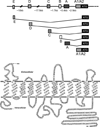Membrane transporters and folate homeostasis: intestinal absorption and transport into systemic compartments and tissues
- PMID: 19173758
- PMCID: PMC3770294
- DOI: 10.1017/S1462399409000969
Membrane transporters and folate homeostasis: intestinal absorption and transport into systemic compartments and tissues
Abstract
Members of the family of B9 vitamins are commonly known as folates. They are derived entirely from dietary sources and are key one-carbon donors required for de novo nucleotide and methionine synthesis. These highly hydrophilic molecules use several genetically distinct and functionally diverse transport systems to enter cells: the reduced folate carrier, the proton-coupled folate transporter and the folate receptors. Each plays a unique role in mediating folate transport across epithelia and into systemic tissues. The mechanism of intestinal folate absorption was recently uncovered, revealing the genetic basis for the autosomal recessive disorder hereditary folate malabsorption, which results from loss-of-function mutations in the proton-coupled folate transporter gene. It is therefore now possible to piece together how these folate transporters contribute, both individually and collectively, to folate homeostasis in humans. This review focuses on the physiological roles of the major folate transporters, with a brief consideration of their impact on the pharmacological activities of antifolates.
Figures






Similar articles
-
Mechanisms of membrane transport of folates into cells and across epithelia.Annu Rev Nutr. 2011 Aug 21;31:177-201. doi: 10.1146/annurev-nutr-072610-145133. Annu Rev Nutr. 2011. PMID: 21568705 Free PMC article. Review.
-
The molecular identity and characterization of a Proton-coupled Folate Transporter--PCFT; biological ramifications and impact on the activity of pemetrexed.Cancer Metastasis Rev. 2007 Mar;26(1):129-39. doi: 10.1007/s10555-007-9047-1. Cancer Metastasis Rev. 2007. PMID: 17340171 Review.
-
New perspectives on folate transport in relation to alcoholism-induced folate malabsorption--association with epigenome stability and cancer development.FEBS J. 2009 Apr;276(8):2175-91. doi: 10.1111/j.1742-4658.2009.06959.x. Epub 2009 Mar 9. FEBS J. 2009. PMID: 19292860 Review.
-
The intestinal absorption of folates.Annu Rev Physiol. 2014;76:251-74. doi: 10.1146/annurev-physiol-020911-153251. Annu Rev Physiol. 2014. PMID: 24512081 Free PMC article. Review.
-
Haem and folate transport by proton-coupled folate transporter/haem carrier protein 1 (SLC46A1).Br J Nutr. 2009 Apr;101(8):1150-6. doi: 10.1017/S0007114508066762. Epub 2008 Sep 10. Br J Nutr. 2009. PMID: 18782461
Cited by
-
Mechanism of intestinal folate transport during folate deficiency in rodent model.Indian J Med Res. 2012 Nov;136(5):758-65. Indian J Med Res. 2012. PMID: 23287122 Free PMC article.
-
Expression of Folate Pathway Genes in Stage III Colorectal Cancer Correlates with Recurrence Status Following Adjuvant Bolus 5-FU-Based Chemotherapy.Mol Med. 2015 Jul 17;21(1):597-604. doi: 10.2119/molmed.2014.00192. Mol Med. 2015. PMID: 26193446 Free PMC article.
-
Cancer stratification by molecular imaging.Int J Mol Sci. 2015 Mar 4;16(3):4918-46. doi: 10.3390/ijms16034918. Int J Mol Sci. 2015. PMID: 25749472 Free PMC article. Review.
-
Folate production by probiotic bacteria.Nutrients. 2011 Jan;3(1):118-34. doi: 10.3390/nu3010118. Epub 2011 Jan 18. Nutrients. 2011. PMID: 22254078 Free PMC article. Review.
-
Intraoperative near-infrared imaging with receptor-specific versus passive delivery of fluorescent agents in pituitary adenomas.J Neurosurg. 2018 Dec 14;131(6):1974-1984. doi: 10.3171/2018.7.JNS181642. Print 2019 Dec 1. J Neurosurg. 2018. PMID: 30554181 Free PMC article.
References
Reference List
-
- Stokstad ELR. Historical perspective on key advances in the biochemistry and physiology of folates. In: Picciano MF, E. Stokstad LR, editors. Folic Acid Metabolism in Health and Disease. New York: Wiley-Liss; 1990. pp. 1–21.
-
- Jacques PF, et al. The effect of folic acid fortification on plasma folate and total homocysteine concentrations. N Engl J Med. 1999;340:1449–1454. - PubMed
-
- Matherly LH, Goldman DI. Membrane transport of folates. Vitam Horm. 2003;66:403–456. - PubMed
-
- Matherly LH, Hou Z, Deng Y. Human reduced folate carrier: translation of basic biology to cancer etiology and therapy. Cancer Metastasis Rev. 2007;26:111–128. - PubMed
-
- Kamen BA, Smith AK. A review of folate receptor alpha cycling and 5-methyltetrahydrofolate accumulation with an emphasis on cell models in vitro. Adv Drug Deliv Rev. 2004;56:1085–1097. - PubMed
9.0 Website
-
- For an in-depth up-to-date review of hereditary folate Malabsorption from the clinical and genetic perspectives. http://www.ncbi.nlm.nih.gov/bookshelf/br.fcgi?book=gene&part=folate-mal.
Publication types
MeSH terms
Substances
Grants and funding
LinkOut - more resources
Full Text Sources
Other Literature Sources
Medical

